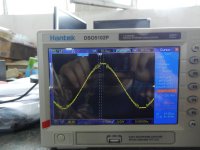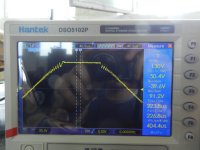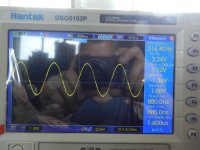For a long time trying to do a simple Class D amplifier to behave well around clipping, like a class AB amplifier, without pre-clipping trick as used now.
As I understand from Eva's old posts, this is close to impossible: http://www.diyaudio.com/forums/class-d/162428-class-d-clipping-help.html#post2104956
"You may not like the result if the output stage of the amplifier is allowed to clip. Clicks, sticking to the rails, and oscillations may be the result. In many class D circuits the modulator is intentionally made to clip before the output stage, or the signal is pre-clipped according to instantaneous supply voltage."
But reading Bruno patent http://d1.amobbs.com/bbs_upload782111/files_28/ourdev_548669.pdf I realize few things:
-Hysteresis switching-"The most important problem is the lack of control over the output filter. The other is that the minimum pulse width produced is only half that of the idle pulse width. The operating frequency swings quite strongly with modulation index, following a parabola with its maximum at zero modulation and hitting zero at maximum modulation.
The result is a very recognizable “tizz” close to clipping, as the switching frequency traverses the audio band. The oscillogram of the output (second order reconstruction filter presumed) is very recognizable."
-Phase-shift controlled oscillation-"A rather pleasing characteristic of this method is that the switching frequency can be made much more stable than with a hysteresis modulator. In theory the minimum pulse width at maximum modulation becomes zero (in practice about twice the propagation delay of the active electronics). Switching frequency still drops to zero in the process, but only much later and much less energy will be in the carrier by that time. After reconstruction by a second order filter the amplitude of the residual remains nearly constant. Even under careful listening conditions, the clipping behaviour sounds indistinguishable from that of a good linear amplifier."
-Phase shift control using the reconstruction filter-This is about Bruno patent, like everyone knows
Posted in as few oscillograms which show the behavior of a prototype ucd style near clipping:
Next, attach two videos which show the behavior with and without pre-clipping method:
ClassD + 110v 4r clipping with limiter - YouTube
ClassD + 110v 4r clipping - YouTube
A few things about the tested amplifier: lm319+74hc02 (deadtime)+ir2110+irfb4332, 4r dummy load, 1khz input, 314khz at idle, ucd style feedback with 2 passive poles.
Waiting for your comments and suggestions.
As I understand from Eva's old posts, this is close to impossible: http://www.diyaudio.com/forums/class-d/162428-class-d-clipping-help.html#post2104956
"You may not like the result if the output stage of the amplifier is allowed to clip. Clicks, sticking to the rails, and oscillations may be the result. In many class D circuits the modulator is intentionally made to clip before the output stage, or the signal is pre-clipped according to instantaneous supply voltage."
But reading Bruno patent http://d1.amobbs.com/bbs_upload782111/files_28/ourdev_548669.pdf I realize few things:
-Hysteresis switching-"The most important problem is the lack of control over the output filter. The other is that the minimum pulse width produced is only half that of the idle pulse width. The operating frequency swings quite strongly with modulation index, following a parabola with its maximum at zero modulation and hitting zero at maximum modulation.
The result is a very recognizable “tizz” close to clipping, as the switching frequency traverses the audio band. The oscillogram of the output (second order reconstruction filter presumed) is very recognizable."
An externally hosted image should be here but it was not working when we last tested it.
-Phase-shift controlled oscillation-"A rather pleasing characteristic of this method is that the switching frequency can be made much more stable than with a hysteresis modulator. In theory the minimum pulse width at maximum modulation becomes zero (in practice about twice the propagation delay of the active electronics). Switching frequency still drops to zero in the process, but only much later and much less energy will be in the carrier by that time. After reconstruction by a second order filter the amplitude of the residual remains nearly constant. Even under careful listening conditions, the clipping behaviour sounds indistinguishable from that of a good linear amplifier."
An externally hosted image should be here but it was not working when we last tested it.
-Phase shift control using the reconstruction filter-This is about Bruno patent, like everyone knows
Posted in as few oscillograms which show the behavior of a prototype ucd style near clipping:
An externally hosted image should be here but it was not working when we last tested it.
An externally hosted image should be here but it was not working when we last tested it.
An externally hosted image should be here but it was not working when we last tested it.
An externally hosted image should be here but it was not working when we last tested it.
An externally hosted image should be here but it was not working when we last tested it.
An externally hosted image should be here but it was not working when we last tested it.
Next, attach two videos which show the behavior with and without pre-clipping method:
ClassD + 110v 4r clipping with limiter - YouTube
ClassD + 110v 4r clipping - YouTube
A few things about the tested amplifier: lm319+74hc02 (deadtime)+ir2110+irfb4332, 4r dummy load, 1khz input, 314khz at idle, ucd style feedback with 2 passive poles.
Waiting for your comments and suggestions.
Attachments
Your scope waveforms are looking rather typical to me, not poorly wrong.
Worth to listen to the clipping and judge by your ears if it is Ok for you.
Besides the tizz, which I agree is linked to the switching frequency traversing the audible range, some desings suffer from short interuptions in operation (duration can range from few hundrets of micro seconds to mulitple ms) which sounds - say.. tackering.
The nice second picture in your posting is not from UcD,
but a phase shift controlled oscilator with pre filter feedback.
..one page later Bruno writes:
Phase-shift controlled amplifiers are in turn sometimes
equipped with additional loop encompassing the recon-
struction filters, again in order to make the frequency
response less dependent on load[2]. An undesirable side
effect is that usually the frequency modulation near
clipping is increased again, producing oscilloscope pic-
tures very similar to the hysteresis modulator.
Well, UcD is not equiped by an additional loop encompassing the filter - UcD has only the loop encompassing the filter.
Worth to listen to the clipping and judge by your ears if it is Ok for you.
Besides the tizz, which I agree is linked to the switching frequency traversing the audible range, some desings suffer from short interuptions in operation (duration can range from few hundrets of micro seconds to mulitple ms) which sounds - say.. tackering.
The nice second picture in your posting is not from UcD,
but a phase shift controlled oscilator with pre filter feedback.
..one page later Bruno writes:
Phase-shift controlled amplifiers are in turn sometimes
equipped with additional loop encompassing the recon-
struction filters, again in order to make the frequency
response less dependent on load[2]. An undesirable side
effect is that usually the frequency modulation near
clipping is increased again, producing oscilloscope pic-
tures very similar to the hysteresis modulator.
Well, UcD is not equiped by an additional loop encompassing the filter - UcD has only the loop encompassing the filter.
Last edited:
- Status
- Not open for further replies.





